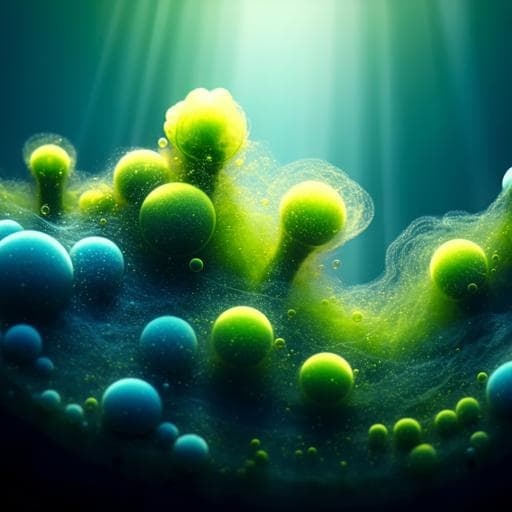
Environmental Studies and Forestry
Combined Earth observations reveal the sequence of conditions leading to a large algal bloom in Lake Geneva
A. I. Rahaghi, D. Odermatt, et al.
Discover how freshwater algae can unexpectedly thrive in lakes, as researchers including Abolfazl Irani Rahaghi and Daniel Odermatt uncover the triggers behind a massive *Uroglena* bloom in Lake Geneva. This study reveals the intricate interplay between weather patterns and algal dynamics in meso-oligotrophic lakes.
~3 min • Beginner • English
Introduction
Phytoplankton blooms in meso-oligotrophic lakes are short-lived and difficult to predict, and although long-term drivers of phenology and bloom frequency are known, the specific triggers of individual events remain unclear. Climate change has been implicated as a broad driver, yet simple correlations with air temperature or precipitation often fail to explain bloom occurrence, underscoring system complexity. In September 2021, an unprecedented massive bloom of the mixotrophic chrysophyte Uroglena sp. occurred in Lake Geneva, drawing public attention and necessitating rapid scientific explanation. The study proposes that short-lived blooms arise from a specific sequence of meteorological and hydrodynamic conditions and aims to causally unravel the 2021 bloom using a multidisciplinary Earth observation framework combining in-situ, satellite, biogeochemical, and 3D modeling tools, and to assess the rarity of these conditions over 1998–2022.
Literature Review
Previous work documents increasing intensity of phytoplankton blooms globally and changes in bloom phenology, with climate change implicated but not determinative for individual events. In oligotrophic lakes, nutrients are often below limiting thresholds and light can constrain production; upwelling events in large lakes (e.g., Baikal, Tahoe, Constance) can episodically supply nutrients to the euphotic zone and stimulate surface productivity. Uroglena and other chrysophytes display mixotrophy, enabling bacterivory and utilization of dissolved organic matter, conferring a competitive advantage under nutrient stress. Extreme precipitation and runoff pulses have been identified as triggers in other systems by delivering nutrients and terrestrial organic matter, influencing microbial loops and favoring mixotrophic taxa. Top-down control may be weak where herbivorous zooplankton are reduced. Littoral zones, often undervalued in large lakes, can become productivity hotspots, with littoral–pelagic connectivity shaping bloom dynamics. Operational forecasting frameworks increasingly integrate satellite color, Lagrangian transport modeling, and hydrodynamics to reconstruct bloom build-up and dispersion.
Methodology
Study site: Lake Geneva (Léman) is a large, deep perialpine lake (70 km length, 14 km max width, 582 km² area) with two basins (max depths ~309 m east, ~70 m west). It is oligomictic; euphotic depth ~12–25 m, often deeper than the mixed layer in spring–summer. Dominant winds (Vent SW, Bise NE) and stratification/bathymetry drive complex circulation.
Monitoring data: Long-term physical/biogeochemical data at SHL2 from OLA/CIPEL (since 1963), hydrometeorological data from BAFU/FOEN and MeteoSwiss; Changins station (1998–2022) for meteorology. High-frequency in-situ data from the LéXPLORE platform (570 m offshore, northern shore) with an autonomous profiler (CTD temperature, AC-S hyperspectral absorption 400–730 nm, ECO BBFL2w chlorophyll-a fluorescence and bb700 at 117°, PAR sensors), profiling top 80 m at 2–8 times/day; ADCP (300 kHz) current profiles below 11 m; thermistor chain (48 sensors, 0–90 m). Additional 1 m temperature at Buchillon station. Water samples collected Sep 10 and 13, 2021 at SP1–SP5 for biogeochemical and taxonomic analyses; additional bulk phytoplankton and water at SHL2 for 14C.
In-situ data processing: Chlorophyll-a concentration (C_chl-a) estimated using absorption line-height (a_LH) method to avoid non-photochemical quenching. Night-time linear relationships between a_LH and fluorometric C_chl-a (avg R²=0.94) applied to daytime a_LH. Subsurface chlorophyll maxima estimated per Zhao et al. AC-S data underwent temperature correction, scattering correction (M2 model), and quality control. Backscattering bb(700) corrected for instrument drift. Euphotic depth from PAR (1% level); diffuse attenuation (k_d,PAR) from exponential fit to top 10 m PAR; Secchi depth z_SD = 1.44/k_d,PAR. Thermocline depth by statistical segmentation maximizing density gradient in the middle layer.
Satellite retrievals: Sentinel-2 MSI and Sentinel-3 OLCI remote sensing reflectance (R_rs) processed by ACOLITE. Three-Band reflectance Index (TBI) computed using 665, 704/709, 740/754 nm as a proxy for chlorophyll-a. Empirical model C_chl-a = 98.77·TBI + 34.76 used to estimate concentrations; z_SD estimated by RGB-QAA algorithm for Sep 6, 2021.
Water sample analyses and radiocarbon: Phytoplankton species identified and counted (Utermöhl). Secchi depth and C_chl-a measured along a littoral–pelagic transect (SP5). Soils/sediments from littoral sources sampled; DOC extracted via shaking. 14C (δ14C) measured with ECHOMICADAS and LMC14, on dissolved inorganic and organic carbon and particulate organic matter; crustaceans processed for 14C. Soil CaCO3 removed prior to analysis; DIC extracted under He and acidification; DOC freeze-dried and measured.
3D hydrodynamic model: Hydrostatic MITgcm configured for Lake Geneva (50 m horizontal grid; 100 vertical layers; surface layers 0.5 m thick to 10.1 m at depth). Initialized at rest with homogeneous temperature profile from LéXPLORE (Jul 26, 2021). Forced by MeteoSwiss COSMO-1 reanalysis (1.1 km). Solar penetration via monthly Secchi depth. Validation showed spin-up ~3 weeks; RMSEs from prior calibration: temperature 0.95–1.45 °C; velocity 0.033 m s⁻¹ at LéXPLORE.
Lagrangian particle tracking: TRACMASS-based 3D advection of inert particles using modeled velocity; no stochastic diffusion or biological terms. Forward tracking: 2000 particles released hourly (0–10 m) along southern upwelling shore starting Sep 3, 2021 00:30; relative particle concentration computed with depth-weighting (constant K_d ≈ 0.41 m⁻¹ from PAR). Backward tracking: 200,000 particles seeded on Sep 6, 2021 12:30 in three main circulation centers (0–5 m) and traced back to Aug 31, 2021 00:30; particle probability maps computed.
EOF analysis: Empirical Orthogonal Function decomposition of depth-integrated horizontal velocity flux (0–20 m, also tested 0–10 m) to identify coherent basin-scale structures; Mode 1 captured multi-gyre circulation.
Long-term meteorological analysis: Daily U10, global radiation Q, air temperature T, and 3-day cumulative precipitation pr at Changins (1998–2022, Jun–Sep). Wind surface energy flux P10 = ρ_air C10 U10³. Parameters smoothed (3-day moving average), mapped to 0–1 using percentiles (wind energy 5th–95th: 0.03–0.12 W m⁻²; precipitation 99th ~55 mm/3 days; radiation 1st–50th: 81–152 W m⁻²; air temperature 1st–50th: 10–18 °C) and a normalized sigmoid. Three prerequisite probabilities computed: heavy rainfall within prior 60 days (max over window), strong wind energy within prior 7 days (mean), calm and warm following 7 days (means of T, Q, and 1−wind). Bloom probability P(bloom) = product of the three; significant threshold arbitrarily set at >0.75.
Key Findings
- Satellite and in-situ characterization: Sentinel-2 on Sep 6, 2021 showed widespread high TBI indicating large regions (>5 km wide) with very high chlorophyll-a (C_chl-a > 50 mg m⁻³) and low transparency (Secchi depth z_SD < 3 m), with extremes along southern shores. In-situ profiles showed subsurface chl-a and backscatter maxima shifted to the surface (~0.5–3 m), evidencing a surface bloom. The bloom was extraordinary relative to long-term records.
- Taxonomy: The bloom was dominated by Uroglena sp., a motile colonial mixotroph; monospecific dominance at most sampled sites on Sep 10. Typical odor and color reported. Uroglena remained dominant through Sep 13 with strong spatial heterogeneity (C_chl-a 4.4–22 mg m⁻³; z_SD 1.6–3.2 m within <1 km at SP1).
- Timing and patterns: Sentinel-3 OLCI suggests onset between Sep 2–4, initially along southern shore, peaking Sep 6. Spatial patterns included 1–10 km structures: mushroom-like features in the west/center and an eastern gyre with filaments, indicating complex hydrodynamic advection of biomass.
- Modeled circulation and transport: MITgcm reproduced observed patterns; forward particle releases near the southern shore (from Sep 3) led to western/central mushroom-like structures; backward tracking from the eastern structure suggested pelagic trapping with weak littoral connection. EOF Mode 1 (62.2% variance; Mode 2 12.3%) revealed three basin-scale rotational gyres (west weak anticyclonic, center strong anticyclonic, east strong cyclonic) plus a smaller eastern anticyclonic eddy, sustaining lateral heterogeneity for ~4 days after onset.
- Upwelling: In the four days preceding the bloom, northeasterly winds induced coastal upwelling along the southern shore, lifting the thermocline by ~10 m into the photic zone; weaker upwelling occurred along the northern shore.
- Carbon source (14C): Littoral bloom sample (SP2, Sep 10) was strongly 14C-enriched (δ14C = 1.225) relative to atmosphere (just under 1.000), indicating terrestrial carbon incorporation. Soil/subsoil organic matter from eroded littoral areas slightly enriched (δ14C 1.00–1.05), with DOC from shaking tests δ14C 1.04–1.08. Conversely, bloom samples from harbor and pelagic locations (Sep 10–15) and pelagic waters (Oct 2021) were 14C-depleted (δ14C 0.806–0.884), similar to dissolved inorganic carbon (δ14C 0.851–0.860). Interpretation: initial littoral fueling by terrestrial OM for mixotrophy; subsequent pelagic phase supported by lake bicarbonate.
- Meteorological niche: A calm, warm, sunny period favored Uroglena colony formation in the top 5 m. Records show: windy cold period (Aug 24–31) followed by calm, warm period to Sep 8 with high daily global radiation; average net heat gain ~94 W m⁻² promoted productivity and allowed gyre-driven dispersion without disruptive mixing.
- Extreme rainfall and runoff: Extreme precipitation (>55 mm over 3-day window; >99th percentile) occurred 6–8 weeks before the bloom (also similar in 1999), elevating lake level (>30 cm), causing bank erosion and terrestrial inputs. Proposed sequence: rainfall-driven pulses enhanced nutrients and terrestrial OM, fueling microbial loop and Uroglena mixotrophy prior to bloom onset.
- Zooplankton control: 14C signatures in zooplankton resembled open-water bloom signature; Daphnia may have exploited biomass but could not control it due to weak top-down control in Lake Geneva and Uroglena colony morphology (size, mucilage) reducing grazing vulnerability.
- Rarity of the sequence: Long-term (1998–2022) analysis identified only three occasions with high probability (>0.75) of the required sequence (1999 end-July; 2021 mid-July; 2021 early September). The two documented Uroglena blooms (1999, 2021 early September) coincide with two of these. The mid-July 2021 non-bloom likely due to a short lag (<10 days) after heavy rain, insufficient for microbial processing of terrestrial OM. Each prerequisite is individually frequent, but their exact sequence is rare.
Discussion
The study demonstrates that the exceptional 2021 Uroglena bloom in Lake Geneva was not driven by any single factor but by a precise sequence of meteorologically induced processes interacting with lake hydrodynamics and littoral–pelagic connectivity. Heavy rainfall delivered terrestrial organic matter and nutrients to the littoral zone, enabling mixotrophic growth via bacterivory. Subsequently, wind-driven coastal upwelling injected hypolimnetic nutrients into the euphotic zone along the southern shore, priming conditions. A following calm, warm, sunny period supported colony formation and net heat gain, facilitating high surface productivity and allowing gyre-dominated advection to shape broad spatial patterns. Particle tracking and EOF analyses mechanistically linked littoral sources to pelagic bloom structures. Radiocarbon results provide an independent tracer line of evidence for a transition from terrestrial OM-supported growth in the littoral to bicarbonate-supported photosynthesis in the pelagic. The rarity of the specific temporal sequence over multiple decades explains why such blooms are exceptional in a low-nutrient system despite frequent occurrence of individual prerequisites. These findings refine understanding of short-lived bloom triggers, highlight the pivotal role of sequence and timing under climate variability and change, and emphasize the importance of littoral–pelagic connectivities in large lakes.
Conclusion
Meteorologically driven sequences—extreme rainfall/runoff, wind-induced coastal upwelling, then calm and warm weather—triggered and sustained an exceptional Uroglena bloom in meso-oligotrophic Lake Geneva. Bloom origin was primarily littoral, with basin-scale gyres advecting biomass into the pelagic and shaping spatial structures. Radiocarbon evidence indicates initial reliance on terrestrial organic carbon followed by bicarbonate-supported growth offshore. Long-term analysis shows that while each prerequisite is common, their precise sequence is rare, accounting for the infrequency of such blooms. The study underscores that bloom development depends on dynamic sequences rather than static trends in atmospheric forcing. It advocates for multidisciplinary, coupled Earth observation systems (remote sensing, in-situ, 3D modeling) and recommends next steps such as incorporating growth and mortality into particle tracking, and implementing fully coupled 3D hydrodynamic–biogeochemical or hybrid deterministic/data-driven models. Future research should evaluate how climate-driven changes in extreme event timing and intensity alter the likelihood of such triggering sequences and bloom dynamics in nutrient-limited lakes.
Limitations
- The hydrodynamic–Lagrangian framework neglected diffusion and biological processes (growth, mortality, mixotrophy), assuming advection-dominated transport; thus, it cannot simulate biomass evolution quantitatively.
- Upwelling is common in Lake Geneva and alone cannot explain the bloom; causality relies on coincident sequencing inferred from observations and models rather than controlled experiments.
- The long-term bloom probability threshold (>0.75) is arbitrary; mapping and smoothing choices (percentiles, sigmoid) affect estimated probabilities.
- The absence of a bloom in mid-July 2021, despite favorable sequence probability, indicates unmodeled lags and biogeochemical processing (e.g., microbial loop timescales) that were not explicitly represented.
- Satellite retrievals used empirical algorithms for C_chl-a and z_SD and a constant attenuation for depth-weighting, introducing uncertainties.
- Radiocarbon interpretations assume representative sampling of littoral and pelagic end-members; spatial heterogeneity may not be fully captured.
- Model initialization and forcing rely on reanalysis and limited in-situ constraints; small-scale turbulence and nearshore processes may be under-resolved.
Related Publications
Explore these studies to deepen your understanding of the subject.







